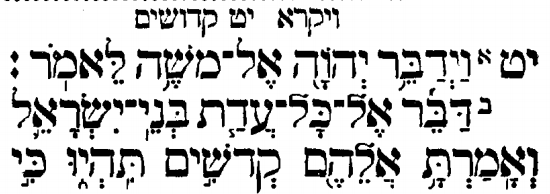Summary: Does Kedoshim Tihyu refer backwards (to Arayos) or forwards (to the Aseres HaDibros)? Also, dual parsings of Ki Kadosh Ani | Hashem Elokeichem, helping establish the idea that each instance of Ani Hashem Elokeichem can function in a unique manner.
1) Consider the words “Kedoshim Tihyu” in pasuk 2. What does this mean? It is a machlokes between Rashi and Ibn Ezra. Rashi says look back, Ibn Ezra says look forwards.
Rashi d”h kedoshim tihyu says look back, meaning even though this is a new sidra, this Kedoshim Tihyu is a summary of what preceded. So look back to the end of Acharei Mos and see the discussion of Arayos. And realize, based on various prooftexts, that in general Kadosh means Parush, separating.
Meanwhile, Ibn Ezra says look forwards. You might have thought to say like Rashi that staying away from Arayos was sufficient to let you stay in the land. Therefore it tells us in the beginning of this new Sidra a bunch of other mitzvos required to stay in the land.
And these mitzvos correspond to the aseres hadibros. And this pasuk of Ki Kadosh Ani Hashem Elokeichem corresponds to the first of the 10 commandments, namely Anochi Hashem Elokecha. (This according to the many who hold that Anochi Hashem Elokecha is the first commandment of the 10, rather than it being an introduction, with Lo Yihyeh Lecha being the first and the two lo sachmods being the final two commandments).
Ibn Ezra lists how these map, but you can scan the pesukim and spot the obvious ones. For instance, pasuk 3 has two dibros, of Kibud Av VaEm and Shabbos. And pasuk 4 has the commandment against idolatry.
Perhaps we can take this machokes as to how Kedoshim Tihyu binds and arrive at a philosophical nafka mina, as to what makes one Kadosh. Is it asceticism or is it performing the mitzvos?
2) The next fun part of the pasuk is “Ki Kadosh Ani Hashem Elokeichem”.

It messes with our minds. Should it be Ani Hashem Elokeichem, like the instances both beforehand in Acharei Mos and afterwards in Kodeshim? After all, that is how every segment is concluded. Look at the end of pasuk 3 and pasuk 4.
Or should it be Ki Kadosh Ani? After all, we are giving a reason for Kedoshim Tihyu, and so this is imitatio Dei, to emulate God. Mah uh kadosh a fata kadosh. Certainly this is the peshat and purpose in this pasuk, because otherwise (if Ani Hashem Elokeichem works alone) the pasuk does not read straight, with Ki Kadosh Ani going to nothing.
So it is “for holy am I YKVK your God.”
But still, we are tugged in two directions at once, to both parsing, and both messages are meant to be sent.
Given this deliberate play on Ani Hashem Elokeichem, we can grant credence to the various local meanings attributed by various meforsim to each Ani Hashem Elokeichem. For instance, Ibn Ezra here that it maps to Anochi Hashem Elokecha of the Aseres Hadibros.
Or in pasuk 3, with the juxtaposition of kibud av with Shabbos, to inform to disregard your father’s command to violate Shabbos. Why? Rashi explain that Ani Hashem, and so both you and your father are obligated in My Honor.
See in each place how the meforshim interpret it.

1 comment:
for correspondece to the aseres hadibros see ויק"ר כ"ד ה' , תנחומא בובר ג. also brought in חזקוני, רא"ש
Post a Comment